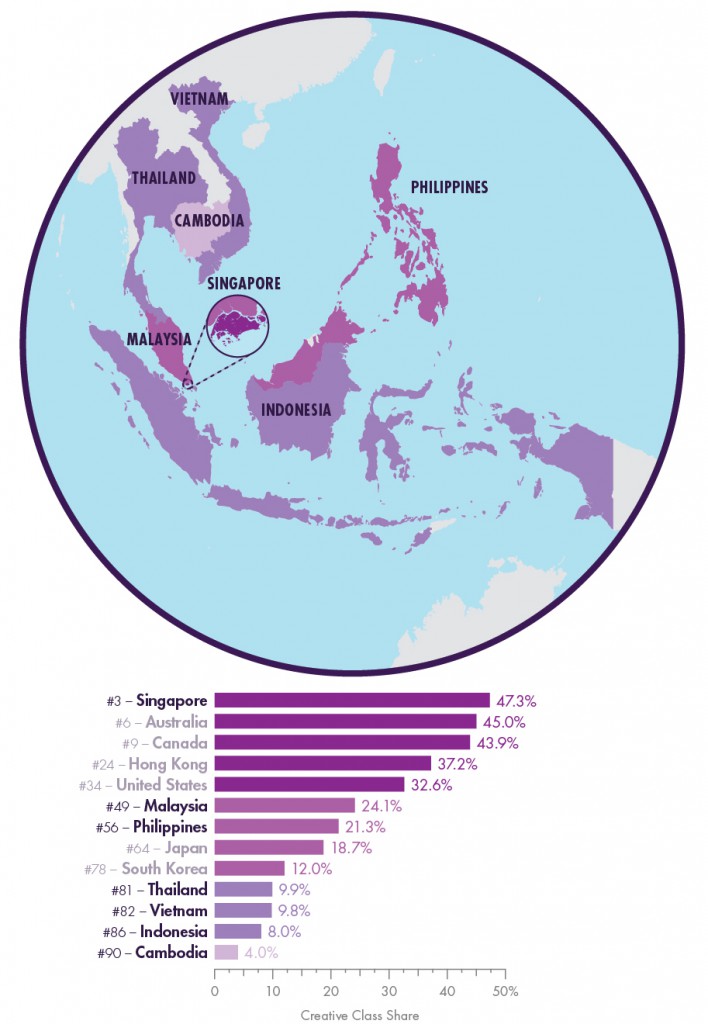Southeast Asia is currently at the center of a significant economic transformation. The region, which spans Singapore, Indonesia, Malaysia, Philippines, Thailand, Vietnam, and Cambodia, is undergoing rapid growth and urbanization. By 2030, the region’s urban population will swell by an estimated 100 million people, growing from 280 million today to 373 million people.
The Rise of the Urban Creative Class in Southeast Asia, a new Martin Prosperity report by Richard Florida and Melanie Fasche, examines the intersection of urbanization and the rise of the new middle class, or urban creative class, in Southeast Asia.
Exhibit 1 shows how the Southeast Asian nations stack up in terms of the share of their workforce that make up the creative class and compares them to international benchmarks.
Overall, Southeast Asia can be divided into four tiers of development.
Singapore occupies the first tier. With $51,149 in economic output per person it is one of richest and most developed nations in the world — ahead of Canada and the United States. With nearly half of its workforce in the creative class, Singapore is third worldwide, ahead of the United States and on par with Australia and Canada.
Malaysia and the Philippines occupy a second tier with economies that are developing rapidly and a substantial creative class. The creative class makes up a quarter of Malaysia’s workforce and a fifth of that of the Philippines, approaching the levels of advanced nations. Malaysia has a level of economic output per person ($9,748) which places it among the world’s “upper-middle income” nations. Roughly three-quarters of its population is urbanized, not far off that of the United States and advanced nations. The Philippines economic output per person ($2,360) also places it firmly amongst “lower-middle income” nations, though less than half of its population is urbanized.
Thailand and Vietnam fall into a third tier. The creative class comprises roughly 10 percent of their workforces. Thailand’s economic output per person ($5,158) places it among “upper-middle income” countries. And about half of its population is urbanized. Only a third of Vietnam’s population is urbanized, and its economic output person ($1,544) places it among “lower-middle income” nations.
Indonesia and Cambodia occupy a fourth tier of development. Indonesia’s economic output per person ($3,323) places it with the Philippines and Malaysia as a “lower-middle income” nation. Just eight percent of its workforce are members of the creative class.
More than half of its population is urbanized. With per person economic output of $869, Cambodia ranks among the world’s “low-income” nations. Just a fifth of its population is urbanized and just four percent of its workforce are members of the creative class.
Southeast Asia’s cities and metros reflect the region’s tiered development pattern.
Singapore occupies the top tier. It ranks as the fourth most advanced global city in the world behind only New York, London and Tokyo and one of the most prosperous and advanced cities on the planet, ranking just below New York City with more than $66,000 in economic output per capita, greater than Tokyo, Toronto, Seoul, and Hong Kong.
Kuala Lumpur occupies a second tier with economic output per capita of $28,000, considerably greater that either Shanghai or Beijing. With $172 million in total economic output, it generates more than half of Malaysia’s GDP and is a bigger economy than Stuttgart or Stockholm.
Bangkok and Manila fall into the third tier, with economic output per person of roughly $20,000 and $15,000 respectively. Bangkok’s economic output of more that $300 billion accounts for more than three quarters of Thailand’s total GDP, making it a bigger economy than Miami or Frankfurt. With nearly $200 billion in economic output, Manila accounts for nearly two-thirds of the Philippine’s GDP, and is a considerably bigger economy than Stockholm.
Jakarta and Ho Chi Minh City occupy the fourth tier with economic output per person of around $10,000 and $8,700 respectively. With total economic output of more than $300 billion, Jakarta’s economy is bigger than Toronto, while Ho Chi Minh City with $71 billion in output is just slightly smaller than Turin or Oslo.
Southeast Asian faces two key challenges moving forward. The first involves the rise of the creative class which is the new middle class or middle class. While some Southeast Asian nations have already developed a sizeable creative class, in others this class is either developing slowly or failing to develop at all. The second is whether urbanization can continue to propel economic development. Urbanization has previously gone hand in hand with economic development and rising living standards. While some areas of Southeast Asia are urbanized, many others have yet to undergo this transformation. These less-developed parts of the region appear to be suffering from “urbanization without growth.” These will continue to be critical challenges for the region, its nations and cities for the future.
Download this Insight (PDF)
